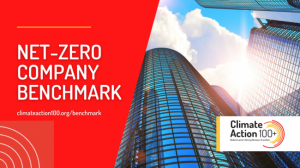From Climate Action 100+, World Wide Web On-Line, 10/5/21
BACKGROUND ~ The Climate Action 100+ initiative was started in December 2017 to engage some of the world’s highest corporate emitters that are systemically important in the transition to net-zero emissions by 2050 or sooner. More than 615 investors, responsible for over $55 trillion in assets, are now signatories to the initiative. Climate Action 100+ commenced with three high-level objectives for focus companies: (1) improved climate change governance; (2) action on greenhouse gas (GHG) emissions across the value chain; and (3) reporting consistent with the Task Force on Climate-related Financial Disclosures (TCFD).
In March 2021, the initiative released the first set of company assessments using the Climate Action 100+ Net-Zero Company Benchmark, which builds on the three high-level objectives of the initiative. The March 2021 Benchmark found that whilst 52% of focus companies have committed to achieve net-zero GHG emissions by 2050 or sooner, there is still plenty of work remaining to ensure that companies develop and disclose robust transition plans.
UPDATE INFORMATION ~ Climate Action 100+ will release the next full iteration (referred to as ‘v1.1’) of the Net-Zero Company Benchmark in March 2022, providing updated company assessments for investors.
Focus companies, investor signatories, and other stakeholders are requested to take note of the processes, timelines, and key dates outlined in this update.
The Net-Zero Company Benchmark is composed of two types of assessments: (1) a Disclosure Framework and (2) Alignment Assessments. These two types of analysis are complementary and share the common goal of helping investors assess a company’s transition to a net-zero future.
The process for carrying out company assessments using the Disclosure Framework for v1.1 in March 2022 will be similar to that followed in 2021, with limited changes to the Benchmark assessment criteria. This is to allow for more timely and frequent iterations of the Benchmark and maintain consistency between the 2021 and 2022 annual assessments.
Through sharing this guidance and process early, companies are called upon to make renewed commitments and disclosures towards aligning with the Climate Action 100+ Net-Zero Company Benchmark and goals of the Paris Agreement. These commitments will contribute to the joint efforts of governments, companies, and investors to address climate change risks and to promote ambitious climate action.
The next Version v1.1 of the benchmark will also contain additional Alignment Assessments (formerly known as ‘Capital Allocation Indicators’). These will include InfluenceMap’s ‘Organisation Scores’ and ‘Relationship Scores’, which assess focus companies’ direct and indirect climate lobbying activities respectively. In addition, they will include new analytics from 2DII measuring the emissions intensities of steel, cement, and aviation companies against reference climate scenarios. All other alignment indicators from CTI and 2DII contained in Benchmark v1.0 released in March 2021 will remain the same.
#######+++++++#######+++++++#######
See Also: Fighting poverty won’t jeopardize climate goals, Science Daily, February 14, 2022
Source: University of Groningen research reports: If the UN Sustainable Development Goal to lift over one billion people out of poverty were to be reached in 2030, the impact on global carbon emissions would be minimal. That sounds good; however, the main reason for this is the huge inequality in the carbon footprint of rich and poor nations.

